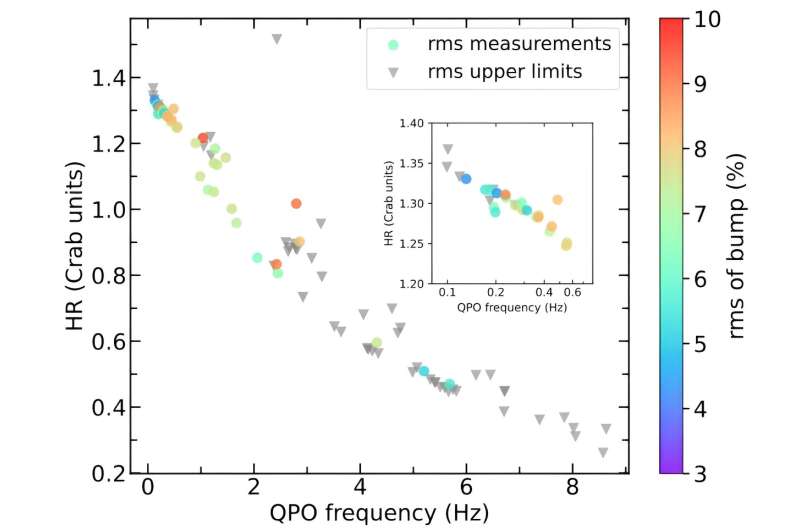November 29, 2023 report
This article has been reviewed according to Science X's editorial process and policies. Editors have highlighted the following attributes while ensuring the content's credibility:
fact-checked
preprint
trusted source
proofread
Research investigates a high-frequency bump in the X-ray binary GX 339-4

An international team of astronomers has inspected a low-mass X-ray binary system known as GX 339-4. Results of the study, reported in a paper published Nov. 21 on the pre-print server arXiv, shed more light on the high-frequency bump observed in the power density spectrum of GX 339−4 and provide more insights into the properties of this system.
X-ray binaries (XRBs) are systems composed of a normal star or a white dwarf transferring mass onto a compact object, which may be either a neutron star or a black hole. XRBs are further divided into low-mass X-ray binaries (LMXBs) and high-mass X-ray binaries (HMXBs), depending on the mass of the accompanying star.
At a distance of about 39,000 light years away from the Earth, GX 339-4 is a recurrent black hole LMXB first detected in 1973. Its black hole is estimated to be at least 5.8 times as massive as the sun. GX 339−4 has undergone frequent outbursts, experienced quasi-periodic oscillations (QPOs) and displayed all the black hole accretion states during the last 30 years.
All in all, GX 339-4 has been comprehensively investigated at all wavelengths, which makes it one of the most studied black hole LMXBs. Previous observations of this system have found a high-frequency bump in its power density spectrum (PDS) that should originate in the X-ray corona. This bump is characterized by a frequency exceeding 30 Hz and has a root mean square (rms) of around 2–3%.
A group of astronomers led by Yuexin Zhang of the University of Groningen, The Netherlands, decided to analyze archival data from the Rossi X-ray Timing Explorer (RXTE), spanning from 1996 to 2012, to explore the nature of this high-frequency bump.
As a result, the team detected the bump in 39 RXTE observations of GX 339-4, all of which also show type-C QPOs in the low-hard state and the hard-intermediate state. They found that the rms of the bump depends on the frequency of the type-C QPO and the hardness ratio (HR).
"When the HR is between ∼0.8 and 1.3 and the QPO frequency is between ∼0.1 Hz and 2 Hz, the rms amplitude of the bump is ∼4–9%, whereas when the HR decreases below 0.8 down to 0.2 and the QPO frequency increases from ∼2 Hz up to 8 Hz the bump is not detected with upper limits of the rms amplitude between 3 and 10%," the researchers explained.
In general, the astronomers found that the radio flux of GX 339−4 is quite low when compared to similar X-ray binaries, but the rms amplitude of the bump is high and the X-ray corona is hot. This indicates that in GX 339−4, more energy in the system in the low-hard and hard-intermediate states is directed towards the X-ray corona than in the case of other investigated black hole LMXBs.
According to the authors of the paper, the presence of the bump in GX 339−4 suggests that in the hard state of this source, most of the accretion energy is directed to the corona instead of being used to eject the radio jet.
More information: Yuexin Zhang et al, A systematic study of the high-frequency bump in the black-hole low-mass X-ray binary GX 339-4, arXiv (2023). DOI: 10.48550/arxiv.2311.12661
Journal information: arXiv
© 2023 Science X Network



















